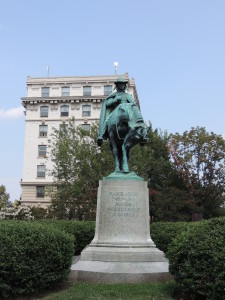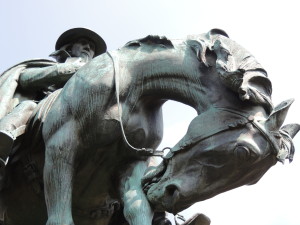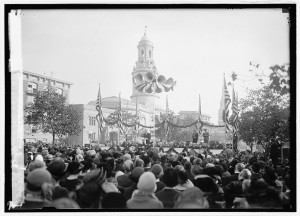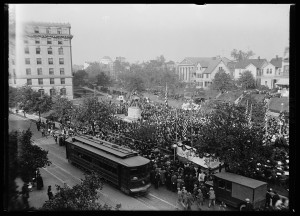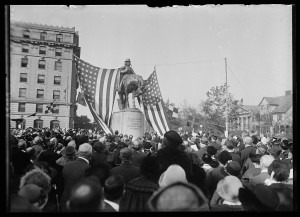The Francis Asbury Statue stands a little over two miles due north of the White House in Washington D.C. The location of this equestrian statue sculpted in bronze and built on its solid granite base resides slightly southeast of the northwest section of the Washington city limits. A little to the northwest of the Francis Asbury Statue is the hilly forest of the Piney Branch park. The park is unique, on its own, the last remains of an earlier period for the capital city. Slightly more than two miles to the west of the Francis Asbury Statue is another reminder of a simpler time, Clover Park. Though somewhat encroached upon, another indication that the D.C. area was once not so populated.
It is fitting that the equestrian monument should nestle close to the two last traces of a rural nation’s rural capital. If “ruralness” was a word it would aptly describe Francis Asbury. The young British preacher at twenty-six years of age left not only the rugged iron-working region in the midlands of England, but also his family, his childhood friends and his girl to set out across the treacherous Atlantic Ocean. His goal was to preach the Gospel to the thirteen American colonies. In time, this focus becomes a regiment that includes more than six-thousand miles on horseback annually. His forty-five-year ministry in America covers more than a quarter million miles on horseback. Seldom do his travels place him in a city environment. He nearly dies in the saddle at the age of seventy-one in rural Virginia.
The inscriptions on the Francis Asbury Statue confirm the arduous travels of the itinerant preacher who braved the wilds of an untamed American wilderness:
“IF YOU SEEK THE RESULTS OF HIS LABOR YOU WILL FIND THEM IN OUR CHRISTIAN CIVILIZATION,”
“HIS CONTINUOUS JOURNEYS THROUGH CITIES VILLAGES AND SETTLEMENTS FROM 1771 TO 1816 GREATLY PROMOTED PATRIOTISM EDUCATION MORALITY AND RELIGION IN THE AMERICAN REPUBLIC.”
“FRANCIS ASBURY 1745-1816 PIONEER METHODIST BISHOP IN AMERICA.”
Finally on the back of the Francis Asbury Statue read the words which succinctly bring it all home:
“THE PROPHET OF THE LONG ROAD.”
It is also fitting that the design, build and erection of the Francis Asbury Statue was without expense to the American government. Francis was a frugal man. He was influenced by frugal leaders of the movement started by John Wesley in England. John and Charles Wesley were the prophets of industry and virtue, they left their mark on Francis Asbury. For England and the brothers Wesley, hard work and discipline were the recipes which rescued not only the individual seeking God but also the populace of Great Britain from its rampant illiteracy and addiction to gin. In light of these dutiful efforts, the Francis Asbury Statue was a gift to the United States by the Methodist Episcopal Church in America. The Methodist organization completing the sculpting of the Francis Asbury Statue in the year 1921.
During a leap year, the 66th Congress of the United States under President Woodrow Wilson approved the site and location of the Francis Asbury Statue on February 29, 1919. At this point, the newly-formed Francis Asbury Memorial Foundation began its efforts to raise monies to design and build the Francis Asbury Statue.
For the design of the Francis Asbury Statue, The Francis Asbury Memorial Foundation chose Mr. Evarts Tracy. Mr. Evarts Tracy was a distinguished architect in the New York architectural firm, Tracy, and Swartwout. Again, a fitting association with the Francis Asbury Statue is that Mr. Evarts Tracy was the great-great-grandson of Roger Sherman, a signer of the American Declaration of Independence. Furthering the appropriateness of Evarts Tracy’s appointment to design the Francis Asbury Statue is that his ancestor Roger Sherman was the only Founding Father to sign all four founding documents of America, the Articles of Association in 1774, the Declaration of Independence in 1776, the Articles of Confederation in 1777 and the U.S. Constitution in 1787.
One last item of note concerning Mr. Evarts Tracy is that during World War I, he was commissioned to design camouflage techniques for the troops on the front line. One of his better-known camouflage designs was the sculpted carcass of a dead horse, lying on its side, attached to a demolished four-wheeled, wooden cart. The piece was utilized to hide one army troop. Inside the crafted work, an observer or sniper would slide himself into the fake and hollow carcass of the animal strategically placed for optimum observance or execution.
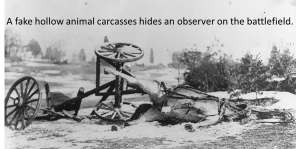
Evarts Tracy
Designer of
Francis Asbury Statue
and Military Camouflage
Mr. Evarts Tracy began his design for the Francis Asbury Statue in the year 1919. Once a design was completed the Francis Asbury Memorial Foundation chose the company to build the Francis Asbury Statue. In the year 1921, the Roman Bronze Works of New York was chosen to build the equestrian memorial. The Roman Bronze Works in turn commissioned the independent artist, Henry Augustus Lukeman to sculpt the Francis Asbury Statue.
Mr. Augustus Lukeman was an American born in 1872 Richmond Virginia. At the early age of ten he began to sculpt with wood and clay. He was introduced to sculpting through a workshop at the New York-based Boy’s Club. From the age of thirteen to sixteen, he studied sculpting under the Irish immigrant artist, Launt Thompson. By the age of sixteen, Augustus Lukeman gained an apprenticeship at the New York City-based foundry founded by Mr. John Williams. He remained in this learning program until 1891 when he reached the age of nineteen. For the next few years, Augustus Lukeman spent his days studying and working with terra cotta for architectural building designs. In the evenings, he divided his time studying drawing techniques and antiques at the Cooper Union for the Advancement of Science and Art. Mr. Augustus Lukeman also had the privilege of studying at New York’s famed National Academy of Design.
By the summer of 1924, Augustus Lukeman was nearing completion of the Francis Asbury Statue.
The equestrian monument generously depicted the rural country preacher. Atop his faithful steed, the weathered itinerant sat looking forward along an unending trail. In his right hand, a Bible rests tightly against his chest. Draped over his square shoulders is a cape to protect from the elements. His broad-brimmed hat an added layer of protection from the scorching summer sun rays that beamed their way through densely forested hillsides. At his back are saddle-bags which secure atop the large rump of a muscled animal who easily seems equal to the tasks which his master calls him.
The horse of the Francis Asbury Statue also indicates Francis Asbury’s numerous struggles through the virgin American wilderness. The animal’s head bends down, some say to lick his leg, perhaps to heal a wound from an errant branch poking from a thickened trail. Perhaps the head of the horse in the Francis Asbury Statue is bent to shoo away a nasty horse fly determined to gain a free meal of the horse’s anatomy. For me, the bending of the horse’s head displays the long travels the itinerant experienced, long travels without food. This would indicate that the horse is bending for a bite of late-summer grass that has reached a more easily accessed height. Regardless of one’s take on the indication of the bend of the horse’s head, the sculptor’s choice to display the horse’s strong teeth are in line with the entire sculpture’s hard-to-miss theme of gritty perseverance.
Wednesday, October 15, 1924 at 2:30 pm, several thousand people gather to view the dedication ceremony for the Francis Asbury Statue. Dignitaries from Washington D.C. seat on the white-draped platform. Hanging from left to right around the rear of the wide stage is a pine bough, clearly a nod to the rural travels of Francis Asbury. Several American Flags hang erect in the almost non-existent wind. Even the stillness of the flags urge that Asbury would have enjoyed a few less-windy days in his travels. At the center of the platform is a wood podium. Atop the speaker’s stand is a microphone. This twentieth-century apparatus undoubtedly powers the numerous loud speakers at the top of the metal pole in front of the prime location. The technology of the day hovers like a gyral-areophone set to observe and deliver the key points of the day’s events.
The photos from the day were taken from an advantageous viewpoint. Obviously from higher ground, either a building across the street or a perfectly placed hilltop. In one of the photos of the Francis Asbury Statue dedication, a trolley streetcar sits on the road. It obviously traveled along the rails embedded in the asphalt street. Electrified since 1888, the Washington D.C. streetcars were the predecessors of the twentieth-century bus system begun in the 1960’s.
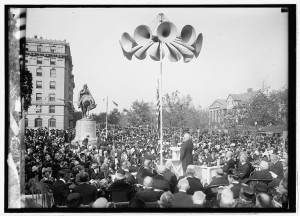
Francis Asbury Statue
Dedication
President Coolidge October 15, 1924
In another photo of the Francis Asbury Statue dedication event, President Calvin Coolidge is giving his much-awaited address. As master of this august ceremony, President Coolidge gives the famous phrase about Francis Asbury which many who know of Asbury are familiar with, “He is entitled to rank as one of the builders of our nation.” President Coolidge’s speech is worthwhile to read. Not only does the speech point to the merits of the ministry efforts of Francis Asbury, President Coolidge’s words go much deeper, ranking Christianity as the main reason for America’s success:
“On the foundation of a religious civilization which he (Francis Asbury) sought to build, our country has enjoyed greater blessing of liberty and prosperity than was ever before the lot of man. These cannot continue if we neglect the work which he (Asbury) did. We cannot depend on the government to do the work of religion. We cannot escape a personal responsibility for our own conduct. We cannot regard those as wise or safe counselors in public affairs who deny these principles and seek to support the theory that society can succeed when the individual fails.”
Another photo from the day of the dedication of the Francis Asbury Statue shows the manner in which the statue was vailed before the ceremony. Two large American flags hang vertically on either side of the equestrian monument. In the magnificent photo, the flanking flags have been pulled back to reveal the spectacular Francis Asbury Statue. The shot taken from the crowd level is a stunning depiction of Francis Asbury and the flags of his adopted country. A country in which he spent nearly his entire life leading the people of the frontier to Jesus Christ.
For the full speech given by President Coolidge, click on this link.

